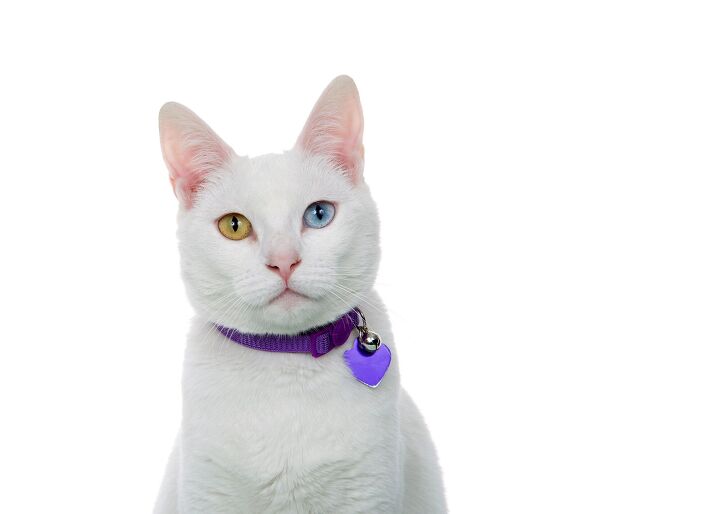How to Train a Cat to Wear a Collar

Whether you want to take your cat on outdoor adventures or want to be sure your kitty will be easier to find if they dart out the door, a cat collar can give you peace of mind. The tricky part is training your feline to wear a collar. Although this can be a little challenging, it isn’t impossible, and some cats take to it more readily than others.
Keep reading to learn about some of the ways to get your cat used to wearing a collar.
Tips for Finding the Best Cat Collar
Choose a safe cat collar that will be comfortable for your kitty to wear so they won’t want to try to take it off.
- Styles: Unlike buckle collars, breakaway cat collars will fit securely but fall off when enough pressure is applied to pull them open. This makes them safer because, in the event that your pet gets their collar caught on something, it won’t keep them stuck and risk injury or strangulation.
- Materials: When browsing collars made specifically for cats, check the materials that they’re made of. Select those that are lightweight and durable. Many also have reflective materials that make it easier to see a cat at night. An elastic collar can be dangerous, especially if a cat tries to get it off but gets stuck in the process.
- Bells and ID tags: Accessories include a cat collar bell, which many products come with, and cat collar tags with your contact information. If you or your kitty don’t like having a bell on the collar, simply remove it.
- Proper fit: You can measure your pet’s neck so you’ll know how big the collar needs to be if you aren’t sure which size to purchase, but many manufacturers sell collars that are adjustable, in sizes for kittens and adult cats.
How tight should a cat collar be? Once the collar is on your cat, two of your fingers should easily yet snugly fit between the collar and their neck—this will tell you if it’s too loose or too tight.
Even the most durable collar can break down over time, so check it often to be sure it’s in good shape. Also, check its fit, especially as your kitten grows or if your cat’s weight changes.
GoTags Personalized Engraved Reflective Cat Collar with Breakaway Buckle
This breakaway custom cat collar doesn’t have an ID tag because your information (cat’s name and your phone number) is engraved onto the material of the collar itself. It’s made of nylon that’s soft, durable, and snag-proof, and it’s reflective so your pet can be seen more easily in low-light conditions. Available in multiple colors, it’s adjustable from 8 to 12 inches, and it comes with a removable bell.
TagME Cat Collar with Name Tag
This is another customizable cat collar that doesn’t require a separate ID tag that hangs from it. It has a stainless steel nameplate engraved with your contact details. Designed to be comfortable and safe, this reflective nylon collar has a quick release buckle and comes in two adjustable sizes and various patterns and colors. The bell is removable. Plus, there’s an optional AirTag holder.
GoTags Stainless Steel Pet Tags
These pet ID tags come in various shapes and colors, and can be added to a cat’s collar with the split ring. Available in two sizes, they’re made of durable, polished stainless steel that won’t rust, break, or bend. Plus, you can add a lot of information with four lines of engraving on each side, for a total of eight lines.
Go Slow and Use Positive Techniques for Training
Gently introduce the collar to your cat. Ensure that they’re relaxed before starting your training.
To make the collar smell familiar, you can rub it on your pet’s bed or another object that they’ve gotten their scent on. Then, let them sniff and look at the collar so they realize there’s nothing to be afraid of.
Throughout the training process, go as slow as you need to ensure your cat doesn’t get frightened or stressed. You might have to spend days on each step of the training, from showing your cat the collar for the first time to actually putting it around their neck. Use treats as rewards to keep the experience positive.
How to put a collar on a cat
To get the collar on your cat, one technique involves holding it up in front of them with one hand and holding a treat in the other hand. Encourage your cat to put their head through the loop to get to the treat, so that the collar will land on their neck. Do this many times until they’re fine with having the collar on. Then, adjust it for a proper fit. Here’s a video demonstrating this.
If your cat is easygoing, you might not need to train them. Instead, you might be able to gently and slowly place the collar around their neck and clip it on while they’re relaxing.
Test things out and observe
Once the collar is on, see how your cat reacts. Distract them with treats and play. If they manage to get the collar off, put it back on and reward them with praise and treats. At the beginning, you can leave it on for a few minutes at a time.
If your cat tolerates it, increase the amount of time that the collar is on from one day to the next. There’s no need to rush. Eventually, you can leave the collar on for a few days, taking it off each night and whenever you leave home.
It’s normal for a cat to want to take a collar off if they’ve never worn one before. By keeping it on them only during the day while you’re at home, they can get used to it little by little.
At every step, observe their reaction and make sure the collar isn’t a safety hazard. See if they try to remove it or get stressed by it.
Note: A bell might annoy a cat because it makes noise when they move. Remove it to see if they’re more comfortable wearing the collar without the bell.
How long does it take for a cat to get used to a collar?
Different cats will react differently to collars. Some might be fine with wearing one right away, while others might need a lot of time to adjust.
But if your cat doesn’t stop trying to remove it, it’s best to take it off. Start the training over, perhaps trying other techniques, such as clicker training, or moving even more slowly. Or, your cat might just be the type that won’t ever wear a collar. In that case, make sure they don’t get outside, and consider microchipping them.
Should Cats Wear Collars?
Even if your cat is indoor-only, and even if they’re microchipped, it’s worth considering the benefits of having them wear a high-quality collar.
A tool for finding a lost cat
There’s the potential that your feline friend could end up finding their way outside and getting lost. If that were to happen, there are strategies to find your lost cat, including reaching out to your local community for help.
If your kitty is wearing a collar with a tag that displays your phone number, anyone who finds them will be able to get in touch with you right away. When writing online posts and flyers about your missing cat, include the collar in the details.
Also, if your kitty goes on mini adventures with you and is trained to walk on a leash, it’s wise to have them wear a collar with an ID tag—or put an ID tag on their harness—just in case they end up getting lost.
No need to scan a microchip
You might be asking if a collar and ID tag is necessary if your cat is microchipped, and the answer is, yes, it can be helpful.
There are many incredible stories of cats being reunited with their family, even if they were very far from home, thanks to their microchip. But a microchip only works if someone scans for it.
Unlike a collar that provides immediate information about a cat’s family, a microchip needs to be scanned by a veterinarian or shelter staff. If someone finds your cat and doesn’t know that a professional needs to scan for a microchip, it could delay or prevent your ability to reunite.
A clue that a cat is someone’s pet
Another thing to consider is that a collar could indicate that a cat is someone’s lost pet rather than a stray. Some people might be more inclined to help a cat who’s wearing a collar.
Be Patient and Gentle When Training a Cat to Wear a Collar
With the right strategy and plenty of patience, you could train your cat to wear a collar, and you might even be surprised by how easy it is. If it’s a big struggle, though, don’t stress your cat out. Some kitties simply refuse to wear a collar, and that’s okay if you’re keeping them safe indoors.
Join the PetGuide community. Get the latest pet news and product recommendations by subscribing to our newsletter here.

Lisa Selvaggio is a freelance writer and editor, and our resident cats-pert, with certifications in pet nutrition and pet first aid. She enjoys producing content that helps people understand animals better so they can give their pets a safe and happy home.
More by Lisa Selvaggio


























